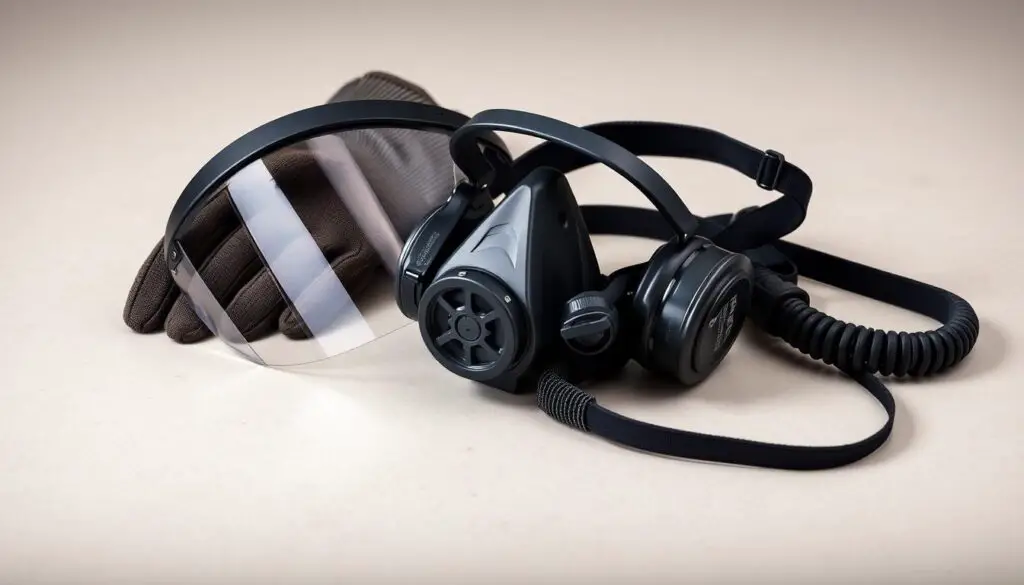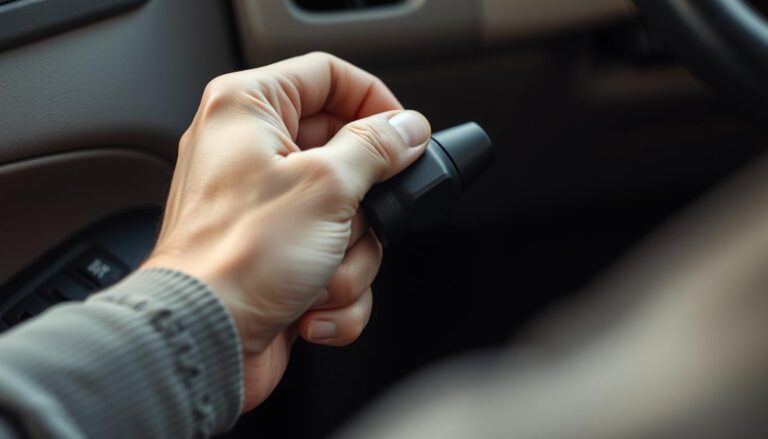This short guide walks a U.S. driver through a safe, targeted method for restoring smoother idle and better performance on many cars and trucks.
The egr system lowers NOx by recirculating exhaust gas into the intake. Over time, carbon builds on passages and on the valve face, which can trigger an engine warning light, rough idle, poor MPG, stalling, and higher emissions.
This piece explains when a non-removal approach saves time and when full service is wiser. It lists basic tools, protective gear, and safe access points so you can use intake cleaners and an OBD2 scanner with confidence.
The method aims to clear mild deposits and improve system response while avoiding unnecessary downtime. If codes persist or deposits are heavy, a removed valve and thorough mechanical cleaning likely offers a lasting fix.
Key Takeaways
- Non-removal cleaning can restore smoother idle and modest performance gains.
- Confirm codes with an OBD2 scanner before beginning work.
- Use proper PPE and targeted intake cleaners for safe application.
- Heavy deposits or persistent codes usually need valve removal and deep service.
- Refer to the service manual for model-specific access points and limits.
Understanding the EGR Valve and Why Non-Removal Cleaning Can Help
The egr system routes a measured portion of spent exhaust back into the intake air stream. This lowers peak combustion temperature, cuts NOx emissions, and steadies part-throttle drivability. A healthy setup often means smoother operation and fewer detonation issues.
The two main types of hardware have different behavior. Mechanical units use vacuum or exhaust backpressure to move the valve. Electronic units respond to ECU commands and sensor input and adjust flow by load and temperature.
Mechanical vs. electronic differences
Electronic systems often flag a restricted passage with a code and light sooner than older mechanical designs. Knowing which your car uses helps you decide which checks to run and whether a non-removal spray approach may help.
Common symptoms of carbon buildup
- Rough idle, hesitation, or surging during part-throttle operation.
- Engine warning light with an egr-related code.
- Reduced MPG and higher tailpipe emissions, or visible dry, sooty deposits that look like a lot of carbon near the flange.
| Feature | Mechanical | Electronic |
|---|---|---|
| Control method | Vacuum/backpressure | ECU with sensors |
| Symptoms onset | Driveability changes first | Codes and light appear sooner |
| Non-removal cleaning effect | Can restore limited flow in mild cases | May need code clear and drive cycle after treatment |
Note: When passages are only lightly fouled, a careful non-disassembly service can soften and flush deposits and buy time before fuller work. If signs persist, a deeper service is usually required to restore proper function in many modern vehicles.
Safety, Tools, and Setup Before You Start
Before you start, gather safety gear and the items listed in your service manual. Working methodically saves time and cuts the risk of accidental damage to engine parts or electrical systems.
Essential equipment includes chemical-resistant gloves, safety goggles, an intake/EGR cleaner spray, soft-bristle brushes, rags, compressed air, an OBD2 scanner, and the vehicle service manual. Keep a spare gasket and basic hand tools nearby in case a mating surface is disturbed.
- PPE first: wear gloves and goggles — atomized cleaner and debris can harm eyes and skin.
- Cleaner and containment: use an intake-safe spray, lay shop towels under the work area, and have compressed air and rags ready to manage softened deposits.
- Scanner and manual: confirm any stored code before work, and follow the manual for access points and components that must not be sprayed directly.
- Engine and battery safety: work on a cool engine and disconnect the negative battery cable before opening connectors or working near moving parts.
If a hose or gasket looks brittle, replace it. If you are unsure about a step, consult a qualified mechanic.

| Item | Why it matters | Tip |
|---|---|---|
| Gloves & goggles | Protects from solvent splash and airborne debris | Use chemical-resistant gloves and tight-seal goggles |
| Intake/EGR cleaner spray | Softens carbon deposits in passages and on the valve | Choose an intake-safe solvent, avoid over-spraying |
| OBD2 scanner | Reads/clears codes and monitors egr-related data | Check codes before and after the procedure |
| Compressed air & rags | Clears loosened deposits and keeps area dry | Blow gently; avoid forcing debris into other hoses |
How to Clean EGR Valve Without Removing It
Start by confirming the unit location in your vehicle manual and planning a safe, stepwise procedure. Make sure the engine is cool and disconnect the negative battery cable before touching connectors or hoses.
Preparation
Verify access at the top and note any nearby vacuum lines. An intake or small modulator hose can serve as a controlled entry point for cleaner. If you must, loosen the EGR feed pipe under the valve for a more direct path; avoid stripping fasteners or nicking gaskets.
Applying cleaner and run procedure
Use short bursts of intake-safe cleaner, then allow soak time so the solvent penetrates carbon and stubborn deposits. After a soak cycle, reconnect components and start the engine at a steady elevated idle as product directions advise. Brief throttle blips help pull solvent through the air path.
Monitoring and test drive
Watch live data with an OBD2 scanner for sensor changes and any stored code. Expect temporary smoke as soot burns off; work in a ventilated area. Finish with a short test drive and check idle, throttle response, and emissions.
Note: Top-side cleaning can reduce restriction but may not replace full disassembly when a valve binds or a cooler is heavily sooted.
Limits, Troubleshooting, and When Full Removal Is Necessary
A targeted spray will clear soot in passages, but sticky stems and pivot points often remain untouched. Non-disassembly work can ease minor restriction and improve idle for a while. However, hardened carbon on the valve stem usually needs full access for a reliable fix.
What non-removal methods can and can’t fix
Limits: Top-side sprays can loosen light deposits, but a valve that still sticks likely has hardened build-up that requires removal. Bench cleaning lets a tech open the part, use a rotary brush, and reach pivots and the throat safely.
Troubleshooting: If drivability improves only slightly or a light returns fast, that looks like residual restriction or mechanical binding. Record codes and steps taken so a shop can quickly click expand on the root cause.
Avoid these mistakes and next steps
- Don’t over-spray — pooled solvent can harm seals and hoses.
- Follow the vehicle manual and avoid tugging brittle lines.
- If codes persist, arrange professional removal, inspect or replace the gasket, and clean the cooler or passages as needed.
Note: After removal, technicians often use a Dremel brush, solvent rinse, and compressed air. Refit with a new gasket and clear codes for a proper finish.
Conclusion
A measured, safe top-side treatment often improves idle and emissions and buys repair time. For many cars this simple step restores acceptable flow in the intake and exhaust crossover and helps engine response while you plan next work.
Use an OBD2 scanner to clear codes and confirm the engine warning light stays off after a test drive. If symptoms return quickly, schedule full removal, bench cleaning, or replacement for a lasting fix.
Document date and mileage, follow the service manual, and use the right cleaner and hose access so the solvent reaches the intended area. Regular maintenance and occasional system-friendly treatments will help preserve performance and emissions compliance for your vehicle.
FAQ
What does an EGR valve do for emissions, combustion temperature, and performance?
The exhaust gas recirculation system reduces nitrogen oxide (NOx) by routing a portion of exhaust back into the intake. That lowers combustion temperatures and helps emissions compliance. When the valve works properly it stabilizes idle and can improve fuel economy; when clogged, it causes rough idle, reduced throttle response, and higher emissions.
How do mechanical and electronic EGR valves differ, and does that affect cleaning?
Mechanical valves use vacuum or direct actuation while electronic versions use solenoids and position sensors. Electronic units require careful handling of wiring and sensors; you should avoid spraying electrical connectors. Mechanical valves tolerate more aggressive cleaning but still need proper access and technique.
What common symptoms indicate carbon buildup in the EGR system?
Typical signs include rough or fluctuating idle, illuminated check-engine light with EGR-related trouble codes, poor fuel economy, loss of low-end power, and increased visible emissions. An OBD2 scan will help identify EGR-specific faults.
What safety gear and tools do I need before attempting a non-removal service?
At minimum use safety goggles and nitrile gloves, a quality EGR/intake cleaner aerosol, clean rags, a lengths of hose for targeted delivery, compressed air if available, an OBD2 scanner, and the vehicle service manual for access details and torque/specs.
How should I prepare the vehicle before starting the spray-and-run procedure?
Park on level ground, let the engine cool enough to work safely, disconnect the negative battery terminal if instructed by the manual, and locate the EGR valve and its intake/exhaust passages. Ensure good ventilation and remove nearby heat sources.
What access options let me deliver cleaner to the valve without removing it?
Common methods are inserting a hose into the EGR vacuum port or into an intake/EGR passage, applying cleaner through a removable vacuum modulator line, or using the throttle-body or intake runner opening for indirect access. Choose the route that gives the most direct spray while protecting sensors and electrical parts.
How should I apply cleaner so it soaks carbon deposits without disassembly?
Use short bursts of EGR/intake cleaner with pauses to let solvent penetrate. Aim the spray through the selected access point toward the valve pintle and passages. Avoid continuous heavy flooding; allow soak time between applications and catch runoff with rags or a drip pan.
What is the correct engine run procedure after applying solvent?
With the vehicle secured, start the engine and hold steady low-to-mid RPMs as recommended by the service manual to circulate the solvent and dislodge deposits. Gradually vary RPMs a few times to exercise the valve. Monitor exhaust and avoid idling in enclosed spaces.
How do I monitor sensors and codes during the process?
Use an OBD2 scanner to read live data and pending or stored trouble codes before and after cleaning. Watch parameters like EGR position (if available), intake MAP, and engine load. Clear codes only after confirming the issue is resolved and then recheck for reoccurrence.
What should I check on a test drive to evaluate effectiveness?
Assess idle stability, throttle response, low-speed drivability, and any return of the check-engine light. Pay attention to smoke, unusual noises, or overheating. A noticeable improvement in idle and throttle response usually means partial success.
Are there differences in non-removal cleaning for gasoline versus diesel systems?
Yes. Diesel EGR systems and coolers accumulate heavier soot and may need stronger solvents or professional hot-tank cleaning. Gasoline systems often respond better to aerosol intake cleaners. Turbocharged engines and EGR coolers need extra caution for backflow and contamination.
What are the limits of non-removal cleaning—what can’t it fix?
Non-removal methods may fail on severe stem binding, heavily fused carbon, damaged valve seats, or failed electronic components. If deposits physically prevent valve movement or the valve hardware is worn, removal and disassembly are usually necessary.
What common mistakes should I avoid during the procedure?
Don’t over-spray or soak electrical connectors, throttle sensors, or MAF sensors. Avoid using harsh pressurized streams that can damage hoses or seals. Never ignore the service manual’s warnings about battery disconnection or recommended RPM ranges.
When should I consider professional removal or replacement?
If codes persist after cleaning, the valve remains stuck, symptoms return quickly, or if the cooler shows internal restriction, seek professional service. Technicians can perform full disassembly, replace gaskets, and inspect sensors and coolers for damage.
Are there alternative products or treatments that help system-wide performance?
Fuel and intake system detergents, periodic professional intake cleaning, and targeted coolant-flush services for EGR coolers can help. Choose OEM-approved or reputable brands like CRC or Sea Foam and follow vehicle-specific guidance.


